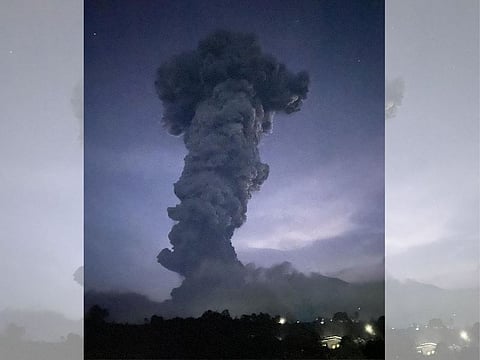'Engine flame out': Why is volcanic ash so dangerous to aircraft?
Volcanic ash poses "engine flameout" hazard to aircraft due to hard, abrasive particles

In 1989, a Boeing 747 (KLM Flight 867) Amsterdam-Tokyo flight flew into a volcanic ash cloud from Redoubt Volcano (Alaska).
All four engines "flamed out".
This recorded incident is an example of the hazards posed by volcanic ash to aircraft in flight.
What an aircraft "engine flameout" means: When an aircraft engine "flames out," it means combustion stops, and the engine loses its ability to produce thrust, likely causing it to spin in a "windmilling" state.
While pilots are trained to handle this by following emergency procedures, like restarting the engine if possible, and preparing for an emergency landing if a restart fails.
Here's a Q&A about the aviation hazards posed by volcanic ash.
What exactly is volcanic ash, and why is it a threat to aircraft?
Volcanic ash consists of very small, hard, sharp-edged particles of rock and volcanic glass (silicates) that form during explosive eruptions, according to the US Geological Survey.
These particles are highly abrasive when they collide with aircraft surfaces, and they can also melt inside jet engines because their melting point (~1,100 °C) is below the operating temperature of modern turbine cores (~1,400 °C).
What kinds of damage can ash cause when a plane flies through an ash cloud?
There are multiple hazards:
Abrasion: Ash erodes forward-facing surfaces such as the cockpit windshield, fuselage, engine inlets, and fan blades.
Engine damage: When ash is ingested into the engine, the silicate particles can melt in the combustion chamber, then re-solidify on turbine blades and guide vanes, reducing airflow, raising pressure, and potentially leading to surges, flameout, or complete engine failure.
System blockage and contamination: Ash can block sensors (like pitot tubes), clog fuel, hydraulic, and water systems, contaminate fuel, and jam mechanical parts. Skybrary notes that ash can interfere with air-conditioning and avionics too.
Corrosion: Volcanic plumes often contain sulfur gases and acidic droplets, which can chemically corrode metal parts, degrade avionics, and damage aircraft components over time.
Visibility loss & instrument error: Ash clouds can sandblast windows, reducing pilot visibility, and cause erratic instrument readings.
Has there ever been a real incident where ash caused serious trouble for an aircraft?
A: Yes.
The USGS reports that there have been "many" encounters between aircraft and volcanic ash.
For example, in 1989, a Boeing 747 (KLM Flight 867) flew into an ash cloud from Redoubt Volcano (Alaska), all four engines flamed out, and the aircraft descended to about 14,000 ft before the crew restarted the engines and landed safely.
While there have been no known fatal crashes solely due to ash ingestion, engine damage can be very costly.
Why don’t aircraft radars detect volcanic ash clouds?
Volcanic ash particles are very small and generally don't reflect radar in the same way as water droplets or large precipitation do.
According to Skybrary, typical airborne weather radar systems cannot reliably detect ash clouds.
Ash particles may also carry an electrical charge, which can lead to phenomena like lightning or “St. Elmo’s Fire” on aircraft.
What measures do airlines and aviation authorities take to mitigate ash risk?
Several systems and procedures are in place:
Monitoring and forecasting: There is a globally coordinated system of Volcanic Ash Advisory Centers (VAACs) that use satellite imagery, ground observations, pilot reports, and numerical dispersion models to track ash clouds and warn aviation stakeholders.
Pilot training & procedures: Pilots are trained to respond to ash encounters (e.g., reducing thrust to avoid melting, exiting the ash cloud, restarting engines when in clean air).
Airport protocols: When ashfall affects airports, there are clean-up procedures, and airports may be temporarily closed if ash accumulates (even less than 1 mm of ash can disrupt operations).
How big is the economic and operational impact of ash clouds?
Very significant. Disruption from volcanic ash can lead to flight cancellations, rerouting, airport closures, and expensive maintenance. For example, the 2010 eruption of Eyjafjallajökull in Iceland caused widespread airspace shutdowns across Europe.
Engine damage from ash ingestion can also shorten engine life, driving up maintenance costs.
Are there long-term risks even from “minor” ash encounters?
Yes. Even low concentrations of ash (or aerosol) can gradually wear down engine parts or control surfaces. Over time, chronic exposure can increase maintenance needs. Also, continued exposure to acidic gases in volcanic plumes can corrode components, as per USGS.
Sign up for the Daily Briefing
Get the latest news and updates straight to your inbox






